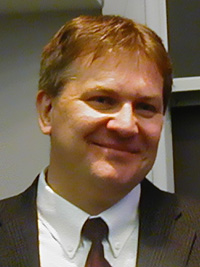Frank J. Stadermann, PhD, senior research scientist in physics in Arts & Sciences, member of the Laboratory for Space Sciences and director of the NanoSIMS and Auger laboratories at Washington University in St. Louis, died of a cerebral hemorrhage Oct. 4, 2010. He was 48.

In his research, Stadermann analyzed Antarctic micrometeorites, presolar grains from primitive meteorites, cometary material and interplanetary dust to catch glimpses of the history of the cosmos and the solar system.
Born in Germany, he earned a master’s degree in physics from the University of Heidelberg, Germany, for work dating lunar rocks returned by the Apollo 14 mission. The rocks were ejecta from an impact event that shattered the moon’s lithosphere, throwing up material from deep inside the moon.
He first came to Washington University in 1988, staying for two years to work in the McDonnell Center for Space Sciences, led by space science visionary Robert M. Walker, PhD, the center’s founding director. The laboratory had acquired an ion microprobe in 1982, and Stadermann used this instrument to measure isotopic ratios in interplanetary dust particles, work that earned him a doctorate in physics from the University of Heidelberg in Germany in 1991.
After his return to Heidelberg in 1991, Stadermann had a postdoctoral appointment in the cosmochemistry department of the Max-Planck-Institut für Kernphysik. At the institute, he studied micrometeoroid impacts on satellite surfaces to evaluate how many were caused by man-made debris in low-earth orbit and how many by cosmic particles.
He continued this line of research after transferring to the Darmstadt University of Technology, also in Germany, where he was in charge of establishing a new SIMS (secondary ion mass spectrometry) laboratory.
While in St. Louis, he met Christine Floss, who was finishing her dissertation on lunar rocks and meteorites for Washington University’s Department of Earth and Planetary Sciences in Arts & Sciences after earning a bachelor’s degree in geology from Indiana University. Floss moved to Germany after completing a doctorate and they were married in 1993 in Heidelberg.
In 1996, Stadermann and Floss were invited to return to Washington University to work with their former advisers, Walker and Ghislaine Crozaz, PhD. Upon his return, Stadermann prepared the laboratory, which is part of the departments of physics and of earth and planetary sciences and the McDonnell Center for Space Sciences, for the arrival of the first commercial version of the NanoSIMS, a high-resolution, high-sensitivity ion microprobe.
He had provided important input for the design of this new instrument. Later, he raised the funds for the acquisition of a scanning Auger microprobe. He crafted cutting-edge experiments that used both instruments to investigate extraterrestrial material. Floss and Stadermann collaborated on much of the research they carried out with these instruments.
In an interview for the Women in Planetary Science blog before Stadermann’s death, Floss, PhD, research associate professor of physics, said, “One of the best aspects to working together with my spouse is being able to completely share the work that I love with the person who is most important to me in life. Because of this, there is no real division between my work life and my private life, but rather there is an ebb and flow to life that sometimes focuses more on work issues and other times moves more to our private interests.”
Stadermann was an adviser for the analysis of samples returned by NASA’s Stardust mission, which flew through the tail of comet Wild 2 in 2004, trapping dust from the comet on one collector and interstellar dust on a collector facing away from the comet.
Stadermann was the first to identify true stellar grains in the cometary collector, samples of which had been distributed to 50 different laboratories. The interstellar collector still is being analyzed.
“Frank took a wonderful delight in research and in the application of new technologies to scientific investigation,” says colleague Tom Bernatowicz, PhD, professor of physics.
“Complicated instruments like the NanoSIMS and Auger microprobe are temperamental, with lots of technical engineering and electronic problems,” says Ernst Zinner, PhD, research professor of physics. “Frank managed all of them with great patience.
“Frank was not only brilliant, he was also the most considerate and helpful person I ever knew,” Zinner says. “Whenever there was a problem, he was there to help. His cheerful nature and positive outlook was always a boost to the spirit of the whole research group. To me, he was like a second son.”
“He never uttered an angry word in all his years at the university,” Bernatowicz says, “always seeking to use patience, humor and reason to undermine conflict and promote harmony. He was a true friend and beloved colleague.”
In addition to Floss, Stadermann is survived by his daughter, Amanda, a junior at Parkway North High School; two stepdaughters, Alisha Hillam of Anderson, Ind., and Ashley Heavilon of Seattle; a granddaughter, Minnie Hillam; his parents, Günter and Margarete Stadermann of Hagen, Germany; and sister Kirsten Stadermann of Zuidhorn, the Netherlands.
A memorial service for Stadermann was held Oct. 8. The family asks that donations in his honor be made to Habitat for Humanity St. Louis (habitatstl.org).